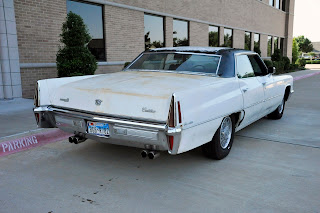It was exciting because the thought of a new car got everybody in the house excited. It must have been a torment for my dad though as each family member had their own opinion about what was cool and what he could afford.
Having read numerous Hot Rod and Car-Toons Magazine, I was an expert in cars by the age of 13. I thought a GTO or Challenger would make a great family car. Instead we bought a 1970 Chevy Impala. It turned out to be the car I learned to drive in but we came close to buying a real beast that year.
For some reason, my father had his eye on a 1969 Pontiac Bonneville. It floated down the road like an airplane and we all got excited about it. On the test drive we took it home and imagined it in our driveway on a permanent basis. Fortunately my father imagined it in our garage and was wise enough to measure it. The signature Pontiac nose wouldn’t fit in the garage unless we poked a hole in the back wall.
I was reminded of that massive Pontiac this week when I came across a 1970 Cadillac Sedan DeVille for sale in our neighborhood. The car isn’t eye catching in the classic car sense but you could say it has curb appeal if you could see the curb.
The car is not the biggest modern Cadillac– that honor goes to the 1976 model – but it is massive in every way. It is more than 6’ wide and about 19’ long. The 472 cubic inch engine could power a fleet of Hondas and the 26 gallon gas tank suggested that fuel efficiency was probably not its strongest selling point.
“The first time I saw the car I thought it would be fun to own,” said Jeffrey Criss, the car’s most recent owner. “My friend was driving it and I suggested we trade. About a year later he came back and swapped the Caddie for a small Ford pickup.” “I think I liked it because it was so long,” he added. “There weren’t many of them around and it certainly caught people’s attention."
After comparing the car’s handling to a boat, Criss let me take the behemoth for a spin. I slid onto the 6’ bench seat and under the thin steering wheel (no adjustable steering wheels here). Just like big dogs take their owners for a walk, the 1970 Sedan DeVille takes its driver for a ride. I barely touched the gas pedal and the car rumbled away.
My short ride brought back more than a few memories of old cars where half the electrical switches didn’t work and the smell of exhaust subtly filled the car.
Still, the 26 year-old Criss says it will be hard to see the car go. “It’s just funky and fun but not the most practical for transportation.”
Anyone who ever pushed and jumped their old, fun and funky car would probably agree.





